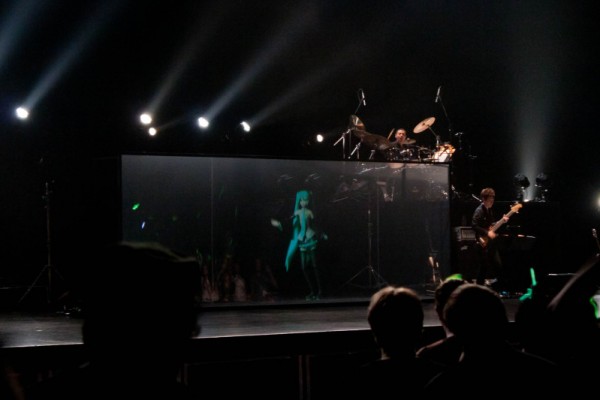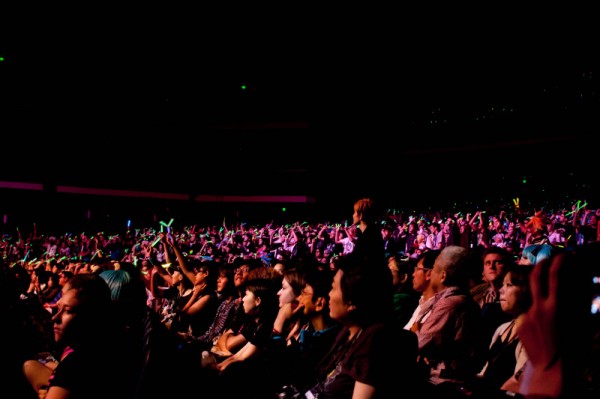Mikunopolis: Hatsune Miku Live in Los Angeles – Concert Report
 As I mentioned in my quick run-through of Anime Expo 2011, there wasn’t any event that left me quite as befuddled as this year’s Mikunopolis concert. The Mikunopolis concert was far outside my usual realm of experiences and I came out of it with more questions than answers. First off, the very concept of rendering a judgement of a concert headlined by a voice synthesizer is already fraught with peril. Unless the song selection was terrible, the concert itself marred by technological glitches, or the choreography half-assed, could any Vocaloid concert be deemed to be less than perfect?
As I mentioned in my quick run-through of Anime Expo 2011, there wasn’t any event that left me quite as befuddled as this year’s Mikunopolis concert. The Mikunopolis concert was far outside my usual realm of experiences and I came out of it with more questions than answers. First off, the very concept of rendering a judgement of a concert headlined by a voice synthesizer is already fraught with peril. Unless the song selection was terrible, the concert itself marred by technological glitches, or the choreography half-assed, could any Vocaloid concert be deemed to be less than perfect?
I may have to defer to the crowd reaction for this one since I’m not the most qualified person to answer such a question. And based on my observations, the crowd was thoroughly entranced; the overall consensus would probably be an enthusiastic “YES!” From my initial vantage point on the balcony, I could see the audience participating wholeheartedly in the performance and, in doing so, putting their own stamp on the whole Vocaloid phenomenon. During the concert, their glowsticks would be moving frenetically during the explosive rock tracks, gracefully during the more flowing songs, or excitedly without care for rhythm when Miku or her other cohorts appeared.
But me? Somehow, I wasn’t able to break through the mental hurdles of fully embracing the notion of a virtual diva. Part of the problem was that the Mikunopolis concert doesn’t have the same sort of unifying feeling that most other concerts possessed. And by that, I mean that I don’t think there was one single reason as to why people attended and enjoyed this concert.
Were people there to witness the technology? There’s no doubt that seeing Miku and company come to life through the projection screen was pretty thrilling, making it one hell of a visual treat. The rapid-paced transitions from one song to the next, while they left fairly little room for the audience to take a breather, were dazzling in the effects that were used. Vocaloid characters would sometimes materialize from clusters of light, some of which were color-coded to correspond to specific characters, thereby heightening the excitement, for instance, when pink-colored light heralded Megurine Luka’s stage appearance. No discussion of the technology would be complete without a mention of how well the characters’ hair and clothing flowed as they danced on stage. The clothing, in particular, was very appealing as they included Rin’s black and white dress that she donned for her performance of the imploring “Meltdown” and Miku’s elegant garb during “Moon.” All of their clothing and hair swished, swayed, and fluttered along with the characters’ movements, making the entire presentation feel pretty lifelike. If showcasing the technology was a goal, Mikunopolis sure was successful in meeting those high expectations.
Were people there simply to see Miku and company? Of the possibilities, this one seems the least explanatory since Miku herself is a bit of a blank slate upon which the fanbase can pour out their (to quote Kylaran’s post, Virtual Diva) “mini-narratives in the form of songs and videos, which in turn brings her to life in such a way that she’s more than character.” So seeing how Miku and friends effectively derive much of their personality through crowdsourcing and the hundreds of interpretations that go into that, it’s very possible that some fans simply attended to listen to a specific song exhibiting a specific trait belonging to their most favorite Vocaloid character.
For me though, my focus was solely on the music, which means that my primary treatment of Mikunopolis is that of a music festival that showcases composers who happen to use Vocaloid as their medium of choice. And there was a lot of music to explore too! The Mikunopolis concert included 23 tracks (setlist located at the bottom) such as the classic ryo(supercell) song “World is Mine” to more recent fare like wowaka’s “World’s End Dancehall” which was sung in garbled English. Because of the edge that Vocaloid has over people, it was more interesting to see performances of songs such as “Two Faced Lovers” or cosMo@(暴走P)’s “Disappearance of Hatsune Miku,” which wouldn’t otherwise be performable by a mere human because both songs featured sections in which Miku would sing the lyrics at a rapid-fire pace – far too fast for any human to enunciate clearly.
But while the Vocaloids took center stage and occupied much of the attention, I found the human elements that surrounded Miku and company to be far more interesting. Prior to the concert, the audience was treated to a DANCEROID routine and I was fascinated in the way the Vocaloid phenomenon spawned a side group of fans who simply love to dance along to Vocaloid music. The way they moved in sync with the music was delightful as they brought out the visual aspect of the rhythms and melodies, rendering the song as a whole engaging on more levels than simply just the auditory one. A shame they didn’t stick around on stage for the remainder of the concert because I would have been interested in seeing human dancers and Miku perform side by side.
The human musicians who were on stage were also excellent, and Miku did take the time to introduce the electric guitar, bass, percussion, keyboard, and the string ensemble. The electric guitarist, in particular, had quite a few shining moments through his solos, which carried an element of virtuosity missing from the vocal part of the concert. His riffs imparted a high-octane dose of energy during the bridge in “StargazeR” and kept me entranced with the skill that he displayed. But nothing impressed me more than the incorporation of the strings and keyboard, especially when it manifested in the wonderfully sublime melody in the closer, “Hajimete no Oto,” which carried the sentiments that made up Vocaloid’s past, while ushering it forward into the future with a gentle touch of hope and optimism.
There may not have been a single, overbearing reason that brought so many fans to the Nokia Theater in the first place, but the fusion of technology, character/personality, and music was on full display, and the overall experience was very exciting. Vocaloid technology is still a long ways away from reaching the point of dominating the musical sphere, and in its current incarnation, it’s not yet able to replace the sort of genuine human emotional expression that lies at the heart of music. So in light of all this, Vocaloid has been, and currently, still is, a curiosity more than anything else, but I do feel the rumblings of change. The proliferation of auto-tuned singers means we’re probably a few steps closer to virtual idol-dom. Now whether the winds of change will whisk away human singers completely, who can say, but for now, I’m not ready to bet against the human performers. At least, not yet.
[spoiler show=”Setlist”]Setlist:
1. Diva Desu
2. World Is Mine
3. Electric Angel
4. Koisuru
5. Clover Club
6. Po Pi Po
7. Romeo and Cinderella
8. Two Faced Lovers
9. Puzzle
10. VOiCE
11. 1/6
12. moon
13. Disappearance of Hatsune Miku
14. Butterfly on the Right Shoulder
15. Meltdown
16. Just Be Friends
17. World’s End Dancehall (English)
18. From Y to Y
19. Saihate
20. Finder
21. SPiCa
22. Ai Kotoba
23. StargazeR
24. Hajimete no Oto[/spoiler]



I do see Miku as merely an ability to ‘enhance’ singing for composers, and not a way to replace human singing itself. Such concerts don’t showcase Miku’s capabilities, but simply use her as a new medium to the composer’s instrumental palette. Human voice and artificial voice will forever be separated, and maybe this concert showed that – it’s obvious that Miku’s artificial, and no attempts were made to deny this.
Off on a tangent, sorta, but I don’t have much more to say. Wish I was there?
Pingback:Virtual Diva: Hatsune Miku’s Popularity and the Sound of the Future » Behind The Nihon Review
The audiences for these look so excited…
Oh man, DANCEROID were there!? Now I actually wish I had been able to go…
To answer your question from my perspective: I didn’t go, but if I had gone, it would not really have been for the music as such. With a couple of exceptions, I don’t like the vocaloid songs I have heard. I do think the idea of vocaloid as a brand new instrument is exciting, though. It is interesting to think of this being a moment similar to the development of the Piano-forte. Can vocaloid have a profound impact on the future of music? Intriguing, but more conceptual than musical.
If I were to have gone, it would definitely have been to experience first-hand the technology demo, not just vocaloid, which is interesting, but of the simulated performances of personality representations. There is a lot of effort being put in to developing robots for many purposes, including “companionship”. It is interesting to consider that physically embodying a robot might not be necessary. Maybe a more practical solution to virtual “companions”, helpers, and other artificial intelligences is a sheet of glass and a projector system? Again, not musical, but quite interesting.
Thanks for the report!
“But while the Vocaloids took center stage and occupied much of the attention, I found the human elements that surrounded Miku and company to be far more interesting.”
That’s really interesting. I suppose humans are hard to replace after all, not even by a manufactured blob of cuteness.
@Mushyrulez
Well, it can replace human beings, especially when it might be so difficult to locate actual human singers to get the job done. Strange as that concept might seem, but that was what happened to one Vocaloid composer, Onyx Kobayashi. And ever since he hopped on board the Vocaloid bandwagon, he hasn’t looked back since.
But as much as I’m betting on the humans now, I’m not sure I’d say this in 10 years time. We’ll have to see how far technology will go!
@Jura
They always do and with a concert of this caliber, who could blame them?
@Caitlyn
They only showed up in the very beginning, but I liked the dancing display that they put forward. Certainly cool how a side industry has spawned around the Vocaloid phenomenon and I kinda wish the footage I got of the DANCEROIDS turned out better.
@Joojoobees
With refining, the technology is capable of reaching the point where it can… dare I say? democratize music production? There are just so many possibilities for synthesized voices to do the kind of music that no human is capable of doing. So far, there haven’t been far too many ventures to dig at the edges, but the initial forays do look promising.
@Yi
Give it ten years and we’ll see!
The human/crowd reactions to (and idealisation of) the Vocaloid characters IS fascinating. A lot of research and writing could be done on how exactly fans think of them – and how different it is or isn’t from ‘real’ celebrity idols. The ability to put your words and feelings in the mouth of your diva is something really interesting when you think about it. I’m reminded of discussion I saw (…somewhere…) about Touhou characters being similarly ‘blank slates’ for fans to project upon.
I love the idea of virtual popstars, and I can’t quite articulate why! But Miku & Co. will never replace human performers, I think. There’s energy in a live human performance which I don’t think can be replicated. Still, there are a fair few manufactured pop sensations who could be replaced by holographic characters and not loose out on any displays of skill and musicianship…
Pingback:初音ミクLAライブ、外国人感想その10(12) - 増田まとめ
Pingback:Kalafina’s Performance at Club Nokia – Concert Report
I hope she comes to singapore but also they fix up a bit the lighting etc. and make it better haha
Pingback:Anime Instrumentality | Hatsune Miku Slated to Perform Vocaloid Concert in Singapore
k, for u ppl who think miku is merely a instrument and cannot replace humans… your wrong. years ago pop, junkie, rock, blue was not popular, disco was the main stream… now? time passes and people changes. watch, later on someone will carry the key of replacement, the wheel of time will spin and all those who are today will become pass time. you can laugh, but thats the truth. of course as much as i hate to admit, some day miku will too, become a pass time.
@aabb
I have no idea what the rise in popularity of those genres have anything to do with Miku replacing humans. For a lot of people, the joy of listening to songs comes from the singer’s ability to express the song’s emotional content and currently, Vocaloid is not there yet in terms of being able to do just that. Whether things will stay that way, who knows? Vocaloid might be able to replace humans or it might not.
I’m a student doing research at UCSD for a professor who would like to interview people who went to this concert for a documentary. If you are interested, please email me at ayeshaucsd@gmail.com : ) Interviews could be done over skype/taped if you don’t live in California. Thank you!!
Hi, nice perspective on Vocaloids. Being an IT professional, I have my own motives to love Vocaloids, specially Miku as the most popular of them. When I first saw Miku, my jaw dropped. I just imagined Michael Jackson voice digitized in Vocaloid (or whatever new SW will be in the future) and his body figure rendered by a computer and “he” singing songs he never sang and dancing steps he never did. It is a matter of time, I think. Maybe not to replace human singers but they will be good enough to gain a share in the entertaiment industry. But I also thought: what if Miku is popular just because you clearly notice she is computer generated (voice and image)?, maybe that is part of what we (vocaloid fans) like. I am not an Anime/Manga fan, but I got hooked with Miku and the Vocaloids.
@Ivanhoeve
Thanks for dropping by! Interesting that you bring up Michael Jackson given what they’ve done with the whole Tupac hologram thing at the recent Coachella. It certainly will work as a way for people to re-live some of those classic music performances.
Also, your thoughts about Miku’s popularity might be right. I tend to adopt a larger view that using her to democratize the music creation process sits well with my worldview since there’s no doubt she’s bringing new composers to light who otherwise would not have had the chance to shine.
Pingback:Plus INT Episode #27 Show Notes : The Prairie
Pingback:Anime Instrumentality Turns 5 - Looking Back On Our Brief History - Anime Instrumentality Blog
Pingback:IA's Vocaloid Concert at Anime Expo Makes a Strong Case for Virtual Idols - Anime Instrumentality Blog